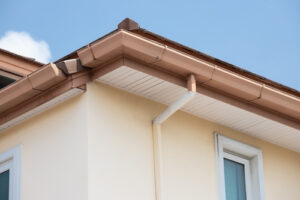Because of exposure to severe weather, gutters can develop corrosion, leaks, holes, and cracks. Steel can be eaten through rust growth, whereas branches or moisture can damage copper or aluminum gutters. Gutter seams that have started to deteriorate can cause leaks and drips. Gutter damage could result in spillage if they droop and overflow. It’s critical to make any repairs and apply patches and seals right away to prevent moisture from accumulating and seriously harming the house. Most people assume that in order to fix gutter leaks, which Top Tier Plumbing and Rooter happily offers for all plumbing services and repairs, you need to hire a professional, but you can actually do it yourself!
You can prevent significant water damage to foundations, sidings, and roofs by learning how to fix leaky gutters. Follow these simple steps to choose and apply the right sealants for fixing leaks, filling cracks, and replacing end caps to keep rain gutters in good working order.
Gutter seams are typically the parts that break the most frequently, largely due to seasonal effects. Gutter systems are frequently constructed of aluminum, a thin metal that rusts easily when water becomes trapped and stagnant inside the trough. This happens when leaves and other debris clog the gutter system.
Before you can correctly patch, seal, or perform any other type of gutter repair, you must first determine the issue and whether it can be fixed or if a replacement is required. If it can be fixed, the rest will go without a hitch.
Clean Your Gutters
Remove all garbage. A putty knife may be needed to remove accumulations of leaves or other debris. Rust can be scrubbed away with a wire brush or cut out with aviation snips. Gutter cleaning with a garden hose is preferable before allowing them to air dry
Put Plastic Roofing Cement to Use
Put plastic cement directly over any small holes in the gutter if there are any. It is crucial to make sure you completely fill them.
Use tin snips to cut a strip of flashing for holes larger than a nail hole if there is a sizable hole. Water from accumulating behind the gutter is prevented by waterproof flashing. Use the same material as your gutter and make sure the area is completely covered. Apply roofing cement next, and then bend the strip to accommodate the flashing in the cement.
Finally, for both holes, round off any protruding edges and finish by spreading roofing cement throughout the vicinity. As a result, proper water flow will be promoted.
Examine the Downspout.
Start by taking out any nearby gutter or downspout pieces that are close to the problematic junction.
Additionally, you should check the condition of your gutter downspouts at this time, and replace them if necessary. Over time, gravity may cause joints to loosen or open up, or they may be jostled from below.
Remove any screws or connecting hardware from the joint before disassembling the downspout’s worn or leaky section.
Change the Gaskets
A joint is one of the most common places for a leak to appear. After thoroughly inspecting these areas, you should make any repairs that are required. To remove caulk or glue from the two parts of the joint, use a hard wire brush. Rubber gaskets on vinyl or PVC gutters need to be replaced.
Check for Other Issues
When you repair gutter leaks, be on the lookout for new gutter issues. Water may overflow from the sagging area of the gutter if the gutter is sagging and preventing water from draining properly. It’s a good idea to keep a level and a measuring tape on hand. A properly constructed gutter will drop about 1/4 inch every 10 feet, directing water toward the downspout. If some areas slump, you might need to replace the hangers holding the gutters up.
Maintain Your Gutters
Maintaining your gutters is crucial to avoiding gutter damage on a regular basis. You’ll be able to avoid problems in the future by doing this. The most important thing is to make cleaning your gutters a regular habit. This is especially important in the fall when leaves
While cleaning your gutters, inspect the entire gutter system to spot any potential problems early. Making gutter repairs as soon as possible can prevent more severe damage. It’s also a good idea to frequently walk around your house’s perimeter. Pay close attention to each downspout to make sure there are no obstructions in the water’s path away from your foundation. If the water isn’t draining away from the house, you might need to alter the landscaping around your downspout.
Gutter guards can be added to your home to help prevent clogs.
Conclusion
For the maintenance and general health of your home, fixing gutter leaks is crucial. You can repair gutter leaks on your own if you follow the above instructions. However, it is not always possible to complete this on your own, and occasionally because of a time constraint, you may want to look for professional assistance. Plumbing Concepts will handle your issue for you! However, regular gutter maintenance is essential; otherwise, you may occasionally need to replace or repair your gutter system.


